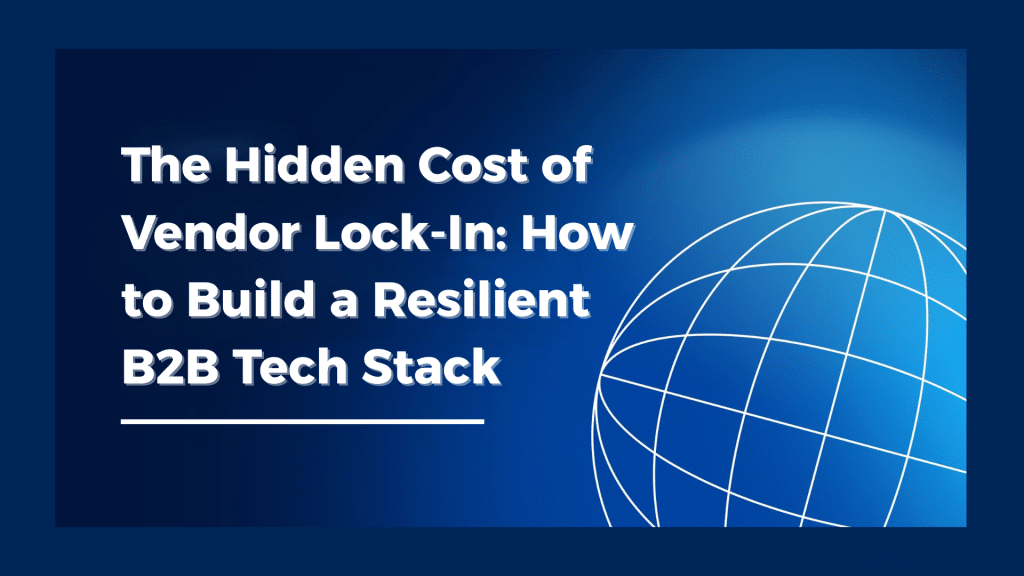Vendor lock-in is a quiet threat that many B2B companies don’t see coming—until it’s too late. On the surface, choosing a major platform vendor seems like a smart, scalable decision. But as your business grows and the market changes, the inability to switch vendors or integrate new tools can cripple your operations, stifle innovation, and drain your budget. In an increasingly interconnected, fast-moving business environment, building a flexible, resilient tech stack is no longer optional—it’s a competitive necessity.
What is Vendor Lock-In, and Why Should B2B Leaders Care?
Vendor lock-in happens when a company becomes overly dependent on a particular supplier for products or services and finds it difficult—or prohibitively expensive—to switch to an alternative. This dependence might arise from proprietary software, complex integrations, long-term contracts, or limited compatibility with other tools.
The issue is especially critical in B2B environments where systems are deeply embedded in day-to-day operations, and switching vendors can cause massive disruptions. Many businesses don’t factor in the long-term cost of being “stuck” with one vendor, and this oversight can hinder digital transformation and reduce overall competitiveness.
Key risks of vendor lock-in:
- Limited flexibility to adopt better technologies
- High switching costs (data migration, retraining, etc.)
- Dependence on vendor’s roadmap, pricing, and support
- Reduced bargaining power and pricing leverage
- Slower innovation due to integration bottlenecks
Real-World Consequences: How Lock-In Hurts Growing Businesses –
Consider a mid-sized SaaS company that built its entire CRM, marketing automation, and customer service around one vendor. Initially, it worked well—but as the company grew internationally, it needed features the vendor didn’t offer. Because their systems were tightly integrated and staff were trained on one ecosystem, switching was a nightmare: they faced months of downtime, massive retraining costs, and even lost data.
These are not isolated incidents. Lock-in issues are emerging across industries, from manufacturing to logistics, where legacy systems can’t talk to newer platforms. Businesses are forced to choose between stagnation or costly, disruptive migrations.
Consequences often include:
- Reduced speed to market with new products or services
- Inability to integrate with modern AI or analytics platforms
- Customer churn due to subpar experience or slow innovation
- Stalled expansion into new markets or channels
- Escalating operational costs with diminishing ROI
How to Identify Lock-In Risks in Your Tech Stack –
Prevention starts with awareness. Many organizations don’t recognize they’re locked in until they attempt to make changes. A proactive audit of your current tech stack can reveal where dependencies lie and where flexibility is lacking.
Look beyond contracts—examine how your teams rely on each tool, how easy it is to extract your data, and whether APIs are open or proprietary. If one vendor controls too many critical functions, you likely have a problem.
Questions to ask in a tech audit:
- Can we migrate our data easily if needed?
- Do we have control over customizations or integrations?
- Are we using open standards or proprietary tech?
- Can we substitute one component without breaking others?
- What’s the true cost—time, money, and risk—of switching?
Building a Resilient, Future-Proof Tech Stack –
To avoid vendor lock-in, companies need to prioritize modularity and interoperability. Instead of relying on a single vendor for an all-in-one solution, adopt a “composable architecture” approach where each part of your stack can be replaced or upgraded independently.
Open APIs, industry standards, and cloud-native technologies make it easier than ever to build such flexible systems. This not only reduces long-term risk but also allows your company to innovate faster and respond quickly to market changes.
Strategies for resilience:
- Choose vendors with open APIs and strong integration ecosystems
- Avoid long-term contracts without exit clauses
- Maintain ownership of your data and portability rights
- Use middleware or integration platforms (iPaaS) to reduce direct dependencies
Collaboration Between IT and Business Teams Is Essential –
Tech decisions can’t be left to IT alone—or made solely by business teams. A resilient tech stack is a shared responsibility. IT brings technical insight into integration and security, while business leaders understand functional needs and strategic direction.
When both sides collaborate, companies are more likely to choose flexible, scalable tools that align with both short-term goals and long-term adaptability. This collaboration ensures that vendor decisions aren’t made in a silo—and that you’re not locking your business into tomorrow’s problems for today’s convenience.
Best practices for collaboration:
- Establish cross-functional buying committees for tech tools
- Align digital infrastructure decisions with business growth plans
- Regularly review vendor performance against strategic goals
- Encourage experimentation with new tools in non-critical areas
Conclusion –
Vendor lock-in is one of those issues that’s easy to ignore—until you’re stuck. A short-term focus on convenience or cost-saving can lead to long-term constraints that limit your business’s growth and innovation potential. In contrast, building a resilient B2B tech stack based on flexibility, modularity, and collaboration gives you control over your future.
By recognizing the hidden costs of vendor dependency and actively designing around it, your business won’t just survive shifts in technology—it will thrive through them.

